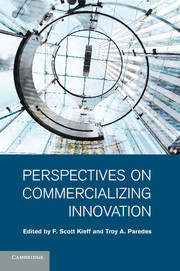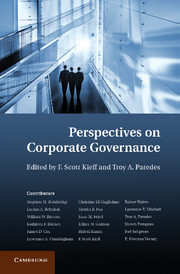28 results

Perspectives on Commercializing Innovation
-
- Published online:
- 05 December 2011
- Print publication:
- 21 November 2011
Part III - Perspectives on Finance and Commercialization
-
- Book:
- Perspectives on Commercializing Innovation
- Published online:
- 05 December 2011
- Print publication:
- 21 November 2011, pp 301-302
-
- Chapter
- Export citation
Contributors
-
- Book:
- Perspectives on Commercializing Innovation
- Published online:
- 05 December 2011
- Print publication:
- 21 November 2011, pp ix-xii
-
- Chapter
- Export citation
Part IV - Perspectives on the University Innovation
-
- Book:
- Perspectives on Commercializing Innovation
- Published online:
- 05 December 2011
- Print publication:
- 21 November 2011, pp 393-394
-
- Chapter
- Export citation
Part I - Perspectives on Theories of Intellectual Property
-
- Book:
- Perspectives on Commercializing Innovation
- Published online:
- 05 December 2011
- Print publication:
- 21 November 2011, pp 7-8
-
- Chapter
- Export citation
Part V - Perspectives on International Considerations
-
- Book:
- Perspectives on Commercializing Innovation
- Published online:
- 05 December 2011
- Print publication:
- 21 November 2011, pp 547-548
-
- Chapter
- Export citation
Introduction
-
-
- Book:
- Perspectives on Commercializing Innovation
- Published online:
- 05 December 2011
- Print publication:
- 21 November 2011, pp 1-6
-
- Chapter
- Export citation
Frontmatter
-
- Book:
- Perspectives on Commercializing Innovation
- Published online:
- 05 December 2011
- Print publication:
- 21 November 2011, pp i-iv
-
- Chapter
- Export citation
Index
-
- Book:
- Perspectives on Commercializing Innovation
- Published online:
- 05 December 2011
- Print publication:
- 21 November 2011, pp 577-580
-
- Chapter
- Export citation
Acknowledgments
-
- Book:
- Perspectives on Commercializing Innovation
- Published online:
- 05 December 2011
- Print publication:
- 21 November 2011, pp xv-xvi
-
- Chapter
- Export citation
Dedication
-
- Book:
- Perspectives on Commercializing Innovation
- Published online:
- 05 December 2011
- Print publication:
- 21 November 2011, pp xiii-xiv
-
- Chapter
- Export citation
Part II - Perspectives on the Problems of Anticommons and Patent Thickets
-
- Book:
- Perspectives on Commercializing Innovation
- Published online:
- 05 December 2011
- Print publication:
- 21 November 2011, pp 177-178
-
- Chapter
- Export citation
6 - Engineering a Deal
- from Part II - Perspectives on the Problems of Anticommons and Patent Thickets
-
-
- Book:
- Perspectives on Commercializing Innovation
- Published online:
- 05 December 2011
- Print publication:
- 21 November 2011, pp 179-210
-
- Chapter
- Export citation
Contents
-
- Book:
- Perspectives on Commercializing Innovation
- Published online:
- 05 December 2011
- Print publication:
- 21 November 2011, pp v-viii
-
- Chapter
- Export citation
PERSPECTIVES ON CORPORATE GOVERNANCE
-
- Book:
- Perspectives on Corporate Governance
- Published online:
- 04 August 2010
- Print publication:
- 30 July 2010, pp xi-xii
-
- Chapter
- Export citation

Perspectives on Corporate Governance
-
- Published online:
- 04 August 2010
- Print publication:
- 30 July 2010
Contributors
-
- Book:
- Perspectives on Corporate Governance
- Published online:
- 04 August 2010
- Print publication:
- 30 July 2010, pp vii-viii
-
- Chapter
- Export citation
Acknowledgments and Dedication
-
-
- Book:
- Perspectives on Corporate Governance
- Published online:
- 04 August 2010
- Print publication:
- 30 July 2010, pp ix-x
-
- Chapter
- Export citation
PART FOUR - DELAWARE VERSUS CONGRESS: ON THE FEDERALIZATION OF CORPORATE GOVERNANCE
-
- Book:
- Perspectives on Corporate Governance
- Published online:
- 04 August 2010
- Print publication:
- 30 July 2010, pp 333-334
-
- Chapter
- Export citation
PART TWO - THE WHY, WHEN, HOW, AND HOW MUCH OF EXECUTIVE PAY
-
- Book:
- Perspectives on Corporate Governance
- Published online:
- 04 August 2010
- Print publication:
- 30 July 2010, pp 115-116
-
- Chapter
- Export citation



